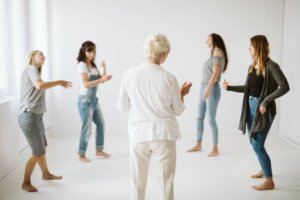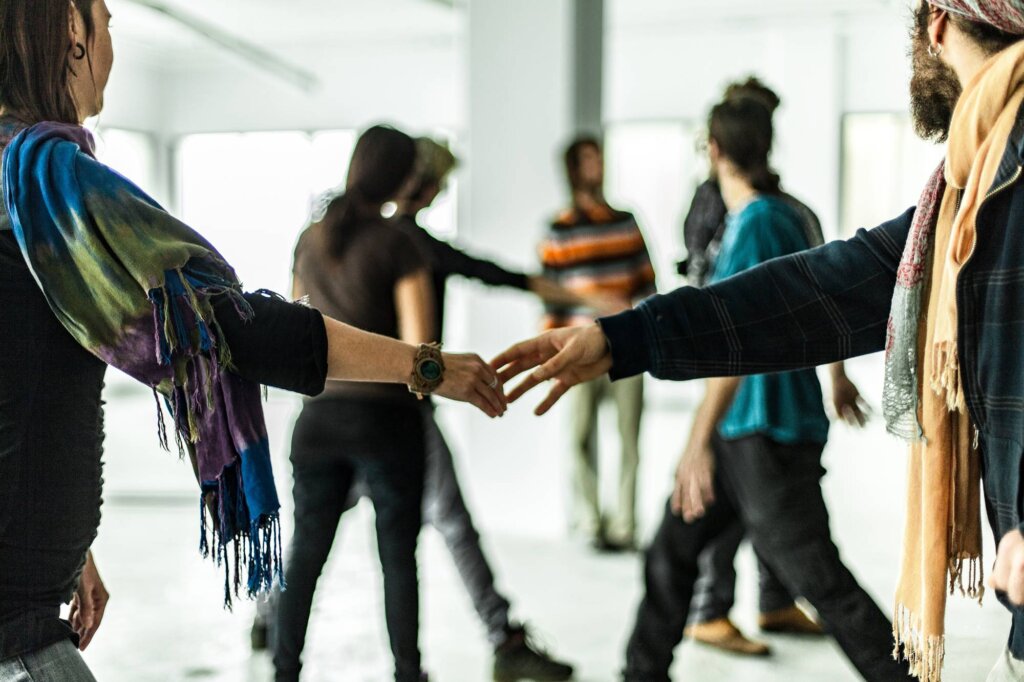Experiential Movement Psychotherapy


Written and verified by the psychologist Valeria Sabater
Experiential movement psychotherapy is on the rise. For instance, in the United States, it’s increasingly common to apply this bodily resource, combined with traditional psychological approaches. It facilitates, among other achievements, emotional, physical, and also cognitive expression. Indeed, patients benefit greatly from this interesting therapy.
Experiential movement psychotherapy isn’t a unique and exclusive therapy. In fact, it’s more of a complementary tool. In effect, it’s a form of non-verbal communication that allows suffering to be channeled in a more accurate way. Interestingly, it’s been proven to be a useful resource for treating schizophrenia. Read on to find out more.
Experiential movement psychotherapy
Body movement has always existed as an expressive and healing mechanism. For example, some really old traditions speak of healing dances, or dances to achieve ecstasy or release evil entities from within.
Often, bodily expression transcends art to connect with the mystical or spiritual. Therefore, it’s hardly surprising that it’s included in the therapeutic field.
Experiential movement psychotherapy is a form of body therapy. It seeks to facilitate the resolution of the patient’s problems and sufferings. Curiously, the model has its roots in the work of the Austrian psychoanalyst, Wilhelm Reich.
This therapy is a complementary approach used by many therapists. In fact, it often helps with mainstream clinical techniques. For instance, cognitive behavioral therapy or acceptance and commitment therapy.

The usefulness of experiential movement psychotherapy
One goal in psychology is for the patient to allow themselves to feel and express what’s inside them. However, it’s often difficult for them to achieve this aim. That’s because there are certain blocks and limitations when it comes to knowing how to put what hurts into words. This is where experiential movement psychotherapy can be useful. After all, above all else, it’s a form of communication.
Research conducted by Dr. Erma Dosamantes was published in the American Journal of Dance Therapy. She claims that experiential movement psychotherapy:
- Externalizes the state of mind.
- Helps the individual become aware of themselves.
- Improves the way they communicate their feelings.
- Connects them with their emotions, needs, and thoughts.
- Is a playful experience. As such, it relaxes tensions and promotes the connection of the patient with their environment.
- Allows the patient not only to become aware of what they feel but also to rediscover their own body through expression and sensitivity.
- Is a pedagogical exercise of self-knowledge for the patient to see themselves as a whole. In fact, their well-being consists of achieving complete harmony between mind and body.
Body expression in therapy promotes the encounter between mind and body. Therefore, the individual can explore their emotions and needs in a playful way.
The usefulness of experiential movement psychotherapy
Experiential movement psychotherapy is an effective resource for almost all types of patients. However, not everyone will be comfortable with this tool. Indeed, it requires a form of disinhibition that may be too radical for some. It’s well worth it though.
This technique is beneficial in scenarios such as the following:
- For people with depression.
- For people with autism. They benefit from body language therapy.
- For people suffering from anxiety disorders.
- For people suffering from eating disorders. Also, those with low self-esteem.
- To work on internal conflicts. For instance, the University of Costa Rica detailed the benefits of body psychotherapy in patients with schizophrenia.
- For people suffering psychological trauma. In fact, in these cases, it’s exceptionally helpful. After all, post-traumatic stress clings to the body and blocks the mind. Consequently, it’s a positive move for the sufferer to get carried away by body expression or dance.
The application of experiential movement psychotherapy
One of the goals of experiential movement psychotherapy is to open new channels of communication for the patient. Traditional therapy is based on conversation and the enriching exchange between patient and psychologist. But, in this case, there’s the opportunity for another intervention mechanism. Moreover, one that’s freer, more dynamic, and cathartic.
So how is this therapy applied? What techniques does it employ? Read on to find out.
This therapy isn’t intended to teach dancing. Nor is it intended that the patient move their body in an organized way. On the contrary, expression and freedom of movement is encouraged.
1. Self-exploration and expression exercises
In this kind of therapy, the patient doesn’t learn dance techniques. It’s not an instructive method, it’s a bodily and expressive tool. One of the objectives is for the patient to become aware of each part of their body. The ultimate goal is for them to find a way to better channel their emotions. They achieve this via relaxation and self-exploration exercises.
Expressiveness is another strategy that allows the appearance of fear, anger, and sadness. The idea is that the patient’s hands, arms, legs, and face move to the beat of each internal emotional state.
2. Group games
Group games are another way of carrying out experiential movement psychotherapy. Therapists propose dynamics in which the body, not the voice is the instrument of communication. For example, role-playing or performing are original instruments in this context.
3. Free dance
Patients dance, move, and express themselves with their bodies in harmony with the music. There are no guidelines, they simply allow themselves to be carried away in total freedom and spontaneity.

Moving and living better
Emotional suffering represents physical and psychological numbness. It’s like living inside a shell, distanced from everything and focused only on discomfort. Body movement allows us to conquer our internal and external spaces. It’s a non-verbal language that channels, releases, and activates self-awareness.
In conclusion, it’s hardly surprising that therapists propose this kind of therapy. Indeed, if you’re willing to take the first step and put any feelings of embarrassment aside, you’ll obtain great benefits. It’s well worth a try.
All cited sources were thoroughly reviewed by our team to ensure their quality, reliability, currency, and validity. The bibliography of this article was considered reliable and of academic or scientific accuracy.
- Aithal, S., Karkou, V., Makris, S., Karaminis, T., & Powell, J. (2021). A Dance Movement Psychotherapy Intervention for the Wellbeing of Children With an Autism Spectrum Disorder: A Pilot Intervention Study. Frontiers in psychology, 12, 588418. https://doi.org/10.3389/fpsyg.2021.588418
- Dosamantes-Alperson, E. (1981). Experiencing in movement psychotherapy. Am J Dance Ther 4, 33–44. Recuperado el 13 de abril de 2023. https://doi.org/10.1007/BF02579623
- Salas-Calderón, Saskia. (2007). Psicoterapia del movimiento: herramienta terapéutica con pacientes esquizofrénicos. Actualidades en psicología, 21(108), 97-115. Recuperado el 13 de abril de 2023, de https://www.researchgate.net/publication/41146782_Psicoterapia_del_movimiento_herramienta_terapeutica_con_pacientes_esquizofrenicos
This text is provided for informational purposes only and does not replace consultation with a professional. If in doubt, consult your specialist.








